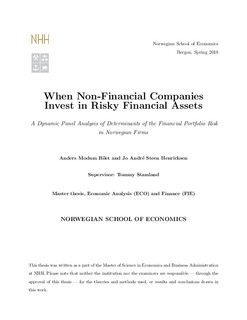When non-financial companies invest in risky financial assets : a dynamic panel analysis of determinants of the financial portfolio risk in Norwegian firms
Abstract
This thesis examines determinants of the risky financial assets of Norwegian firms in the
period of 1999 to 2015. Unlike previous research, and as recently requested in recognized
academic papers, our analysis is aimed at a larger data sample that also consist of small
and unlisted companies. Firstly, we present a literature review, theoretical predictions, and
the applied econometric methodology. Then, empirical findings of pooled and first-difference
OLS, fixed effects, and Arellano-Bond estimations are shown. In support of the theoretical
prediction that financially constrained firms should invest less in risky financial assets, we find
that firms with poor credit ratings have less risky financial asset portfolios. Furthermore, also
consistent with this theory, we find that the investments in risky financial assets are increasing
in the size of the firm. Moreover, firms paying dividends invest significantly less risky. On a
different note, companies with concentrated ownership, and proprietorships, appear to invest
riskier, possibly contrary to our theoretical predictions. Finally, in an attempt to measure
effects of poor corporate governance, we also explore the effects various auditor remarks
have on risky financial assets. One of the coefficients, which we relate to the rationality of
firms’ financial asset management, indicate that firms invest in riskier financial assets if tax
withholdings have not been deposited in a dedicated account, or have not been fully paid.
